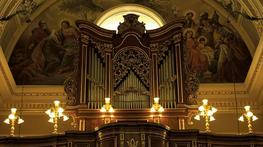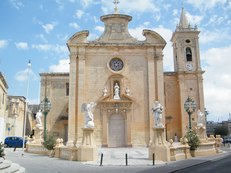Our Lady of Annunciation Parish Church, Balzan
About the Organ

The organ in Balzan Parish Church was built in 1827 by Sicilian organbuilder Felice Platania. It was originally located in a choir gallery behind the main alter ‘in cornu epistolae’. It was a typical one-manual organ with a slider chest accommodating 13 ranks.
In 1898, semi-professional organbuilder Giovanni Felter (who was probably Maltese), dismantled the organ and rebuilt it in the west-end gallery above the main entrance. Of the Platania organ remain most of the pipes, the main slider windchest and its corresponding rollerboard. Felter installed 2 bass windchests, a double-rise parallel bellows with two underlying pumps, a new keyboard and pedalboard, a new stop action, new wind trunks, a new stopped Contrabasso 16’ in the pedal, and new mechanical key and stop action in the North Italian tradition. Hence Felter’s work was significant and the organ should be classified as a Platania-Felter organ after this rebuild.
A few years ago the parish contacted Robert Buhagiar to assess the condition of the organ to determine whether the restoration of the organ could be one of the main projects for the celebrations of the 350th anniversary of the parish in 2005. The organ presented itself in a pitiful state. It had been unplayable for a few years but had not played satisfactorily for decades. It was evident that there were serious problems with the Platania slider chest and Felter’s rebuild had left a lot to be desired. A decision had to be made whether to return to the original Platania organ or restore the organ maintaining Felter’s rebuild. The former would imply removing all Felter’s work and reconstruct much of the organ according to other surviving Platania organs in Sicily (the other Platania organ in Malta was also modified in the past though not as much as the Balzan organ). Though in need of much fine restoration and regulation work, it was decided to retain Felter’s rebuild mostly because his output was quite limited (his other works are on the Gharghur and Msida parish organs)
The restoration started in 2004 with the complete dismantling of the organ. All parts were inspected to assess their condition and decide the best way to conduct the restoration works. The bellows was in such a bad state that it was reconstructed while maintaining only the ribs. The slider and pedal chests were restored to their optimal condition. The rackboard was rebuilt because the original was too badly damaged to maintain the pipework in a stable condition (the original has now been stored inside the organ). The pipework was sorted out in probable Platania ranks and restored while missing pipework was rebuilt. Console parts like the keyboard, pedalboard and stop action were restored. Almost all the wind conveyances were rebuilt and a new silent electric blower was installed while maintaining and restoring Felter’s manual blowing system. The restored organ parts were transferred back to the church in October 2005 and re-assembled. Great care was devoted to the regulation of Felter’s mechanical action which is now performing very well. Finally all pipework was regulated on the typical low wind pressure of Sicilian organs of the period (44mm in water column in this case). Tuning was carried out according to the Tartini-Vallotti scheme since the original temperament could not be traced due to the raising of the pitch, possibly by Felter.
The tonal result has been the greatest success of this restoration and many organists have expressed their appreciation of the beauty and blend of the organ’s tonal characteristics. The organ was inaugurated during an organ recital on Sunday 18th December 2005.
By courtesy of Ing. Robert Buhagiar
In 1898, semi-professional organbuilder Giovanni Felter (who was probably Maltese), dismantled the organ and rebuilt it in the west-end gallery above the main entrance. Of the Platania organ remain most of the pipes, the main slider windchest and its corresponding rollerboard. Felter installed 2 bass windchests, a double-rise parallel bellows with two underlying pumps, a new keyboard and pedalboard, a new stop action, new wind trunks, a new stopped Contrabasso 16’ in the pedal, and new mechanical key and stop action in the North Italian tradition. Hence Felter’s work was significant and the organ should be classified as a Platania-Felter organ after this rebuild.
A few years ago the parish contacted Robert Buhagiar to assess the condition of the organ to determine whether the restoration of the organ could be one of the main projects for the celebrations of the 350th anniversary of the parish in 2005. The organ presented itself in a pitiful state. It had been unplayable for a few years but had not played satisfactorily for decades. It was evident that there were serious problems with the Platania slider chest and Felter’s rebuild had left a lot to be desired. A decision had to be made whether to return to the original Platania organ or restore the organ maintaining Felter’s rebuild. The former would imply removing all Felter’s work and reconstruct much of the organ according to other surviving Platania organs in Sicily (the other Platania organ in Malta was also modified in the past though not as much as the Balzan organ). Though in need of much fine restoration and regulation work, it was decided to retain Felter’s rebuild mostly because his output was quite limited (his other works are on the Gharghur and Msida parish organs)
The restoration started in 2004 with the complete dismantling of the organ. All parts were inspected to assess their condition and decide the best way to conduct the restoration works. The bellows was in such a bad state that it was reconstructed while maintaining only the ribs. The slider and pedal chests were restored to their optimal condition. The rackboard was rebuilt because the original was too badly damaged to maintain the pipework in a stable condition (the original has now been stored inside the organ). The pipework was sorted out in probable Platania ranks and restored while missing pipework was rebuilt. Console parts like the keyboard, pedalboard and stop action were restored. Almost all the wind conveyances were rebuilt and a new silent electric blower was installed while maintaining and restoring Felter’s manual blowing system. The restored organ parts were transferred back to the church in October 2005 and re-assembled. Great care was devoted to the regulation of Felter’s mechanical action which is now performing very well. Finally all pipework was regulated on the typical low wind pressure of Sicilian organs of the period (44mm in water column in this case). Tuning was carried out according to the Tartini-Vallotti scheme since the original temperament could not be traced due to the raising of the pitch, possibly by Felter.
The tonal result has been the greatest success of this restoration and many organists have expressed their appreciation of the beauty and blend of the organ’s tonal characteristics. The organ was inaugurated during an organ recital on Sunday 18th December 2005.
By courtesy of Ing. Robert Buhagiar
History

Balzan always depended by its spiritual welfare on the help given by the Parish Church of Birkirkara. So much so that the vice Parish Priest of Birkirkara used to come to Balzan every Sunday and day of obligation to say mass here. Birkirkara’s Parish Priest used to come to this village to hear confessions, administer the sacraments and bury the dead.
When the apostolic visitor Mgr. Pietro Duzina, visited Balzan on the 1st of February 1575, the number of its inhabitants was 300. When H.L. Mgr Fra Michael Balaguer visited Balzan, a letter dated 19th March 1655 was handed to him in which the inhabitants of Balzan, while giving several reasons, asked the Bishop to segregate Balzan from the Parish of Birkirkara and erect this village as an independent Parish. The Bishop consented to the wish of the Balzan villagers and raised Balzan to an independent Parish on the 14th August 1655.
When H.L. Mgr. Fra Michael Balaguer erected Balzan as a new Parish, he decreed that the XIV century church dedicated to the Annunciation of Our Lady begin to serve as Parish Church and that Fr. Adrian Zarb, brother to the Birkirkara Parish Church Priest, was to be installed as the first Parish Priest of Balzan.
The number of inhabitants was increasing and by 1667 there were about 550 people living in 140 houses, and the old church of the Annunciation was too small for an increasing population. This was five years since Fr. Dominic Ellul was installed as a second Parish Priest. Fr. Ellul had this Parish at heart, and seeing the needs of a new Parish Church he saw that the plans of the new church could cope not only with the exigencies of those days but for the days to come, and this was very true. The plans of the new Parish Church were prepared and never altered.
When the apostolic visitor Mgr. Pietro Duzina, visited Balzan on the 1st of February 1575, the number of its inhabitants was 300. When H.L. Mgr Fra Michael Balaguer visited Balzan, a letter dated 19th March 1655 was handed to him in which the inhabitants of Balzan, while giving several reasons, asked the Bishop to segregate Balzan from the Parish of Birkirkara and erect this village as an independent Parish. The Bishop consented to the wish of the Balzan villagers and raised Balzan to an independent Parish on the 14th August 1655.
When H.L. Mgr. Fra Michael Balaguer erected Balzan as a new Parish, he decreed that the XIV century church dedicated to the Annunciation of Our Lady begin to serve as Parish Church and that Fr. Adrian Zarb, brother to the Birkirkara Parish Church Priest, was to be installed as the first Parish Priest of Balzan.
The number of inhabitants was increasing and by 1667 there were about 550 people living in 140 houses, and the old church of the Annunciation was too small for an increasing population. This was five years since Fr. Dominic Ellul was installed as a second Parish Priest. Fr. Ellul had this Parish at heart, and seeing the needs of a new Parish Church he saw that the plans of the new church could cope not only with the exigencies of those days but for the days to come, and this was very true. The plans of the new Parish Church were prepared and never altered.

